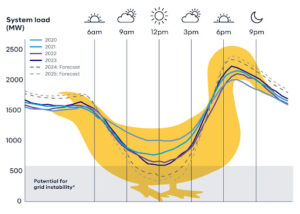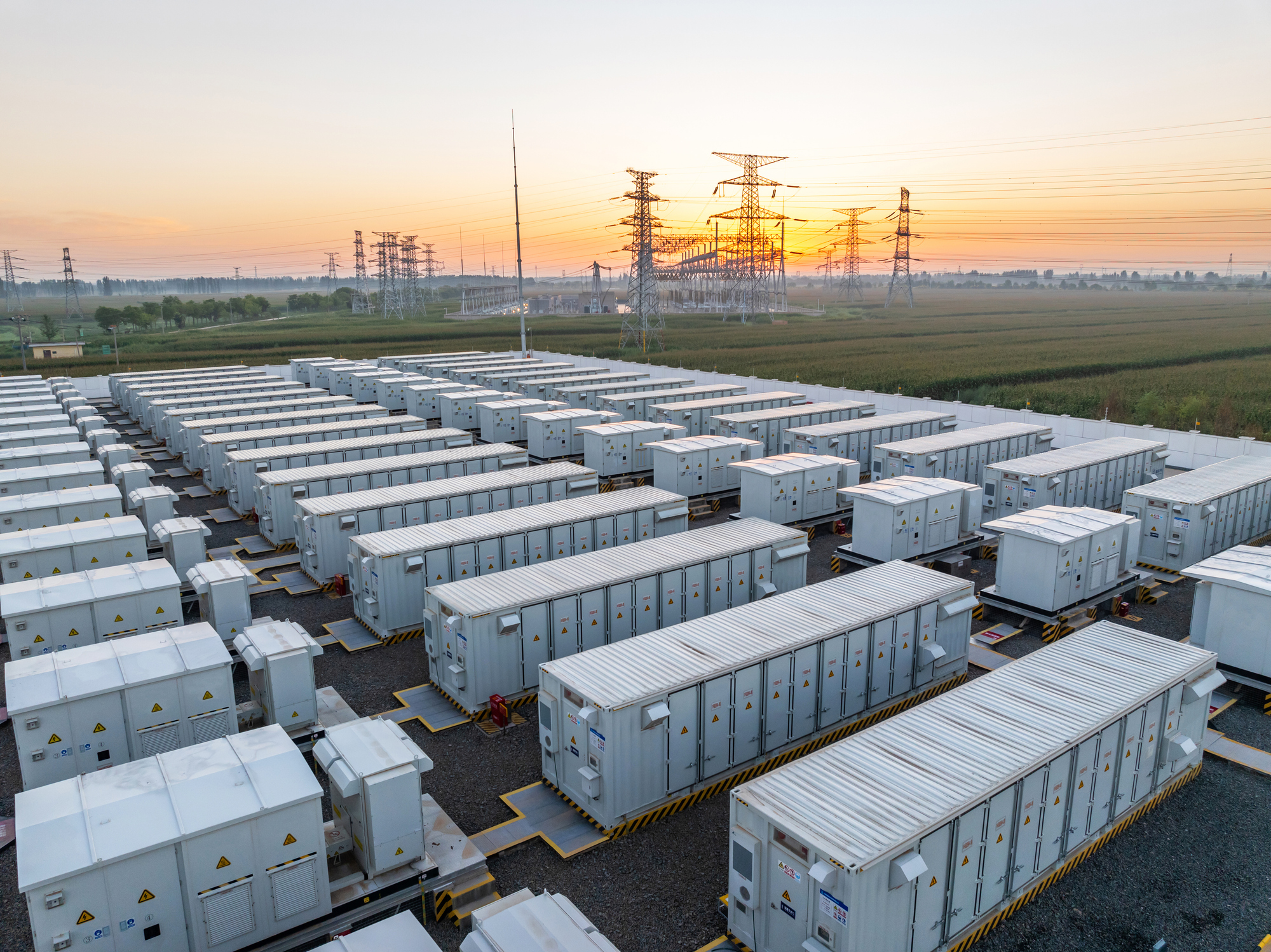Residential solar photovoltaic (Solar PV) installations have accelerated significantly in Australia over the past 10 years. In 2011, Australian industry experts forecasted that rooftop solar PV would eventually yield 4 terawatt hours of electricity, a low figure that barely meets 2% of overall generation needs in the country. That initial forecast has proven remarkably low. Approximately 74% of Australian peak demand is now met using solar PV during daytime hours.
This large figure presents an opportunity for grid operators, retailers, and homeowners to leverage behind-the-meter solar PV into flexibility programs like demand response, bring your own device (BYOD) programs, and virtual power plants (VPPs) to solve complex network challenges.
Whilst solar PV deployments have continued to ramp aggressively, solar feed-in tariffs have plummeted as an excess of solar energy floods the grid around midday. Coupled with this, residential battery systems are growing in sophistication and dropping in cost as economies of scale are achieved, partly due to the rapid adoption of electric vehicles. The two “mega-trends” of solar PV adoption and residential battery storage will shape the energy landscape for years to come.
Residential Solar PV Needs To Be Managed Better
The Australian “solar duck curve” has become more extreme and grid operators have had to move quickly to adopt mechanisms to curtail/constrain to zero solar exports to protect grid stability. However, this runs the risk of wasting generated energy and limits the potential of solar PV to help with overall flexibility and load shifting.

A graphical representation of the ‘Duck Curve’ for the SWIS, created with 2023 data from AEMO and forecast data from Synergy.
The potential of residential solar PV when coupled with residential batteries and a Grid-Edge distributed energy resource management system (Grid-Edge DERMS) is becoming better understood. It is no longer useful to look at individual asset classes in isolation. A holistic bottom-up and top-down approach needs to be taken to get the most out of behind-the-meter DER assets.
– Bernie Emby, International Director of Business Development, Virtual Peaker
Properly orchestrated residential solar PV provides multiple options to solve complex energy market challenges. The challenge is to integrate solar PV and batteries with other consumer energy resources and orchestrate them intelligently via a Grid-Edge DERMS to enable:
- Behind the meter optimization to consume as much solar as possible for air conditioning, water heaters, EV charging, and pool pumps.
- Load shifting to maintain minimum load to ensure grid stability, take advantage of off-peak rates, and curtail summer peak load to ensure grid stability.
- Energy arbitrage to charge residential batteries at peak solar and off-peak times and then discharge them back to the grid at times of peak demand.
Each of these applications can be handled individually, but provide benefits across the value chain of all assets and the grid can be maximised with a Grid-Edge DERMS orchestrating residential assets to deliver maximum flexibility and value to grid operators and homeowners alike.
VPP Capacity Urgently Needed
Operators and regulators recognise the value of increasing VPP capacity as a critical tool during the energy transition to integrate more renewables and meet rising demand. Just a few years ago, reports indicated a disparity between Australian energy retailers’ participation claims and available battery capacity nationwide. To address this, battery growth is expected to increase from the current capacity of approximately 1.7 GW to 18.5 GW by 2035 – an incredible ramp-up.
From 2026 in the Australian energy market, aggregated distributed energy resources (ADERs) can bid/dispatch in markets directly with a minimum 1MW bid size. Aggregated DERs can also provide FCAS services with AEMO and emergency reserves (RERT)- with a block size of 10MW (aggregated DERs) and can be bid/dispatched for min 30 mins.
With these developments, the Australian Energy Market Commission (AEMC) is determined to enable VPPs to directly compete with large-scale generation within the Australian energy market, a sign of the effectiveness and need for the additional load flexibility and distribution opportunities that VPPs provide. Soon, distribution system operators (DSOs) can leverage ADERs for non-network solutions and for managing network constraints.
Flexible Demand Is Critical
Demand flexibility programs come in many shapes and sizes. Broadly speaking, these can be simplified to the following:
- Conservation Efforts – programs like demand response and EV charging shift load to off-peak hours of consumption to mitigate usage during peak periods of demand. In doing so, these programs decrease grid congestion, while defraying the high costs associated with peak energy market purchases.
- Load Shifting – Using a Grid-Edge distributed energy resource management system (Edge DERMS), utilities can aggregate otherwise disparate behind-the-meter battery energy storage systems and solar devices to redistribute communally generated energy stored and produced within the community to repower the grid.
- Energy Arbitrage – Less a specific program and more an economic strategy, demand flexibility initiatives enable energy arbitrage, which intentionally shifts load to off-periods of demand to curtail the need for costly peak energy market purchases. Energy arbitrage is a critical element when calculating ROI for residential battery installations.
When these programs are enabled by a Grid-Edge DERMS that supports real-time control, AI, model predictive control, and advanced forecasting software, the value for networks and stakeholders can be maximised by making behind-the-meter DER assets as reliable as a gas turbine.
Additionally, Topline Demand Control optimizes DER assets at the device level using real-time control and historical data to ensure reliable outcomes for energy providers. For example, if a grid operator requests a specific load shift, Topline Demand Control can optimize all available resources to guarantee that request.
Device Integration – A Key Enabler
Any demand flexibility program is only as useful as the capacity of a grid operator to integrate with devices. As such, when looking to employ demand flexibility and/or solar program programs, the more potential device partners, the better. The more device partnerss, the more opportunity to reach customers and build a VPP that can reach critical mass.
Solar Soaking
For owners of solar energy assets, solar soaking is maximising the energy generated by the solar as it is being generated. Modern Grid-Edge DERMS can aggregate solar and battery energy in real-time, directing that energy where and when it may be most effective. Through real-time flexible dispatching functionality, utilities can direct this energy to mitigate usage, defray high energy costs, and minimize grid congestion.
Maximising The Value Of Residential Solar PV & Batteries In A Distributed Energy Environment Conclusion
With so much solar available, utilities have opportunities to meet rising demand without expensive peak energy market purchases, while defraying infrastructure costs. Using a Grid-Edge DERMS, utilities can leverage real-time device control to aggregate otherwise disparate solar assets for use in any number of potential virtual power plant strategies, without the need for a home energy management system (HEMS). With the right Grid-Edge DERMS, utilities can orchestrate the explosion of behind-the-meter DERs in the market to meet demand when solar is plentiful while implementing Topline Demand Control to shift load and reliably meet energy constraints during peak periods of usage.






